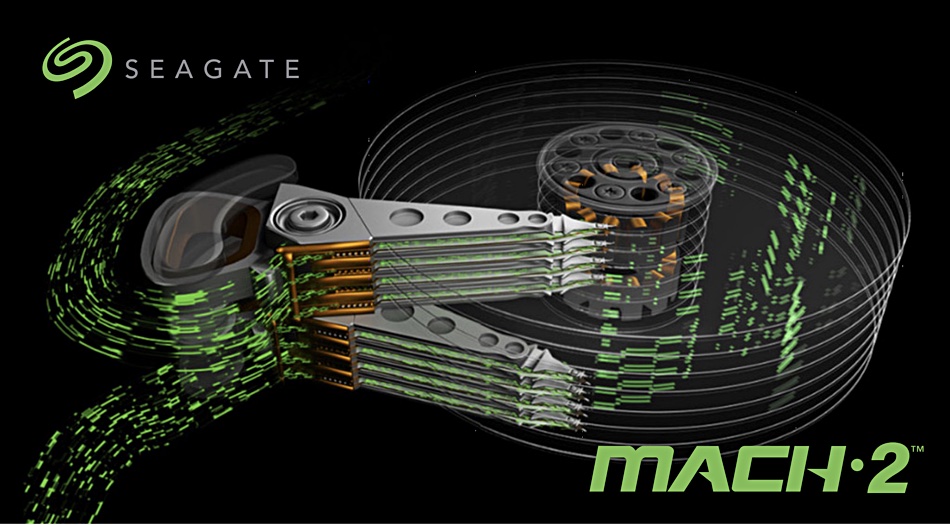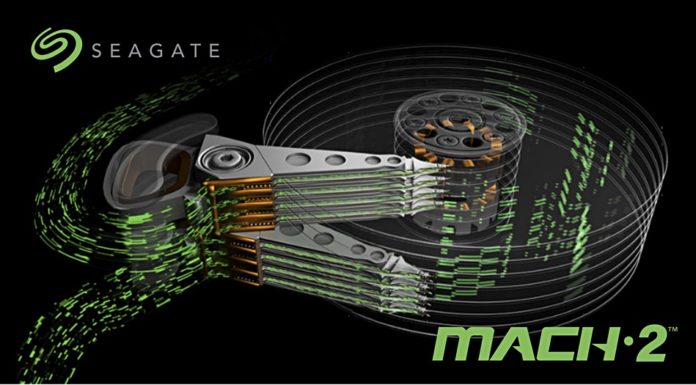Seagate has added a second read/write head to its Exos 16 and 18TB disk drives, more than doubling their data transfer speed.
It dubs this its Mach2 actuator technology, an actuator being a read/write head. The actuators are divided into two sets, with each applying to half the platters in the disks and capable of operating independently from the other set. Seagate has not made a formal announcement about this but the drive has sprung up in its product website pages.

Logically, the Exos 2X18 becomes two 9TB drives, and the two actuators address their own logical unit numbers (LUN0 and LUN1), which are addressed independently by the host’s operating system. The drives can have a 12Gbps SAS port or a 6Gbps SATA port. The SAS protocol supports two such LUNs whereas the SATA one does not. Customers need to modify application software code to support dual-LUN, dual actuator 2X18 drives.
With both SAS and SATA configurations, the user must send commands to both actuators concurrently to see the expected performance benefits. Dual-port SAS configurations are not supported.
The big advantage is the transfer speed with an Exos X18 capable of transferring data at up to 270MBps while the 2X18 bumps this upper limit up to 554 MBps. But the disk’s latency, its seek time, remains the same at 4.16ms.

Which workloads will benefit? A Seagate FAQ says the 2X18 “was designed for hyperscale workloads that focus on low queue-depth random read operations (low queue-depths keep command latencies low) and large transfer size sequential operations. The highest performance gains over a single actuator will be found during high transfer size sequential reads/writes (128KB transfers and larger), random reads (all transfer sizes), and random writes (128KB transfers and larger).”
The applications for this IO pattern are content delivery networks (CDNs), video streaming, mail servers, backup/shuttle services, Ceph, Hadoop (benefits demonstrated at a small scale with HDFS and MapReduce), and cloud applications.

The Exos 2X18 is not a replacement or substitute for SSDs, where the lower latency of SSDs is required or the faster transfer speeds. SAS and SATA interface SSDs, such as Seagate’s own IronWolf Pro 125, have sequential read and write transfer speeds of up to 545MBps and 520MBps respectively so the Exos 2X18 will transfer data faster but their latency will still be lower.
Seagate has a 20TB Exos X20 drive and it uses 10 platters, not the nine in the X18. The extra space needed inside the drive enclosure to accommodate the dual actuator mechanism means that it is not possible to have a twin actuator version of the X20; there being a one-platter penalty, so to speak.
Hardware RAID cards do not support dual actuator drives. Software RAID can support them but data placement algorithms need to be modified such that redundant data from one LUN is not placed in the second LUN inside the same physical drive, thus defeating the object of RAID’s protection against drive failure.
The Exos X18 and 2X18 are conventionally recorded drives. Will we see dual-actuator shingled magnetic media recording (SMR) drives, with their zoned blocks of tracks and overall slower write speed? We think 2023 might bring news on that front.
The Exos 2X18 FAQ can provide more information about the dual-actuator drive’s behavior and characteristics.








